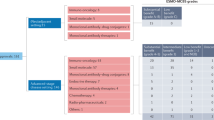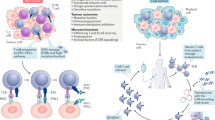Abstract
Approval of new cancer drugs for paediatric patients generally occurs after their development and approval for treating adult cancers. As most drug development occurs in the industry setting, the relatively small market of paediatric oncology does not provide the financial incentives for companies to actively pursue paediatric oncology solutions. Indeed, between 1948 and January 2003 the FDA approved 120 new cancer drugs, of which only 30 have been used in children. This slow rate of development must be addressed in a meaningful way if we are to make progress in the most pressing settings in childhood cancer. In this Viewpoint article, the key opinion leaders in the field weigh in and offer practical advice on how to address this issue.
This is a preview of subscription content, access via your institution
Access options
Subscribe to this journal
Receive 12 print issues and online access
$209.00 per year
only $17.42 per issue
Buy this article
- Purchase on Springer Link
- Instant access to full article PDF
Prices may be subject to local taxes which are calculated during checkout
Similar content being viewed by others
References
Dorsey, E. R. et al. Funding of US biomedical research, 2003–2008. JAMA 303, 137–143 (2010).
Houghton, P. J. et al. The pediatric preclinical testing program: description of models and early testing results. Pediatr. Blood Cancer 49, 928–940 (2007).
Carol, H. et al. The anti-CD19 antibody-drug conjugate SAR3419 prevents hematolymphoid relapse postinduction therapy in preclinical models of pediatric acute lymphoblastic leukemia. Clin. Cancer Res. 19, 1795–1805 (2013).
Kolb, E. A. et al. Initial testing (stage 1) of eribulin, a novel tubulin binding agent, by the pediatric preclinical testing program. Pediatr. Blood Cancer 60, 1325–1332 (2013).
Downin, J. R. et al. The pediatric cancer genomic project. Nat. Genet. 44, 619–622 (2012).
Hovestadt, V. et al. Decoding the regulatory landscape of medulloblastoma using DNA methylation sequencing. Nature 510, 537–541 (2014).
Rumbajan, J. M. et al. Comprehensive analyses of imprinted differentially methylated regions reveal epigenetic and genetic characteristics in hepatoblastoma. BMC Cancer 13, 608 (2013).
Mano, H. ALKome: a cancer subtype with a shared target. Cancer Discov. 2, 495–502 (2012).
Carpented, E. L. & Mossé, Y. P. Targeting ALK in neuroblastoma—preclinical and clinical advancements. Nat. Rev. Clin. Oncol. 9, 391–399 (2012).
PanCare Childhood and Adolescent Cancer Survivor Care and Follow-up Studies. PanCaerSurfFup [online], (2013).
Vassal, G. et al. New drugs for children and adolescents with cancer: the need for novel development pathways. Lancet Oncol. 14, e117–e124 (2013).
Olmos, D. et al. Safety, pharmacokinetics, and preliminary activity of the anti-IGF-1R antibody figitumumab (CP-751,871) in patients with sarcomas and Ewing's sarcoma. Lancet Oncol. 11, 129–135 (2010).
EU Clinical Trials Register. ClinicalTrialsRegister.eu [online].
Zwaan, C. M. et al. The role of the 'innovative therapies for children with cancer' (ITCC) European consortium. Cancer Treat Rev. 36, 328–334 (2010).
Horowitz, M. E. et al. Phase II testing of melphalan in children with newly diagnosed rhabdomyosarcoma: a model for anticancer drug development. J. Clin. Oncol. 6, 308–314 (1988).
Pappo, A. S. et al. Two consecutive phase II window trials of irinotecan alone or in combination with vincristine for the treatment of metastatic rhabdomyosarcoma: the Children's Oncology Group. J. Clin. Oncol. 25, 362–369 (2007).
Ferlay, J. et al. GLOBOCAN 2008: Cancer Incidence and Mortality Worldwide. International Agency for Research on Cancer [online], (2010).
Gottardo, N. G. et al. Medulloblastoma Down Under 2013: a report from the third annual meeting of the International Medulloblastoma Working Group. Acta Neuropathol. 127, 189–201 (2014).
Buczkowicz, P. et al. Genomic analysis of diffuse intrinsic pontine gliomas identifies three molecular subgroups and recurrent activating ACVR1 mutations. Nat. Genet. 46, 451–456 (2014).
Wilmott, G. Regulating clinical trials in Europe. Lancet Oncol. 14, 453–454 (2013).
Vassal, G. et al. Challenges for children and adolescents with cancer in Europe. Pediatr. Blood Cancer 7, 1–7 (2014).
Pritchard-Jones, K. & SIOP Europe. Clinical trials for children with cancer in Europe—still a long way from harmonisation: a report from SIOP Europe. Eur. J. Cancer 44, 2106–2111 (2008).
Pritchard-Jones, K. & Hargrave, D. Declining childhood and adolescent cancer mortality: great progress but still much to be done. Cancer 120, 2388–2391 (2014).
Biondi, A. et al. Imatinib after induction for treatment of children and adolescents with Philadelphia-chromosome-positive acute lymphoblastic leukaemia (EsPhALL): a randomised, open-label, intergroup study. Lancet Oncol. 13, 936–945 (2012).
Kristensen, V. N. et al. Principles and methods of integrative genomic analyses in cancer. Nat. Rev. Cancer 14, 299–313 (2014).
CBTTC. Children Brain Tumour Research Consortium [online], (2014).
Bosetti, C. et al. Childhood cancer mortality in Europe, 1970–2007. Eur. J. Cancer 46, 384–394 (2010).
Smith, M. A., Altekruse, S. F., Adamson, P. C., Reaman, G. H. & Seibel, N. L. Declining childhood and adolescent cancer mortality. Cancer 120, 2497–2506 (2014).
Adamson, P. C., Weiner, S. L., Simone, J. V. & Gelband, H. (eds) Making Better Drugs for Children with Cancer (The National Academies Press, 2005).
Brenner, J. C. et al. PARP-1 inhibition as a targeted strategy to treat Ewing's sarcoma. Cancer Res. 72, 1608–1613 (2012).
Sullivan, R. et al. Improving cancer care for children and young people 4. New policies to address the global burden of childhood cancers. Lacent Oncol. 14, e33–e43 (2013).
Calaminus, G. Paediatric oncology: are there ways to bend the costs? Lancet Oncol. 12, 927–928 (2011).
Calaminus, G., Birch, J. R., Hollis, R., Pau, B. & Kruger, M. The role of SIOP as a platform for communication in the global response to childhood cancer. Pediatr. Blood Cancer 60, 2080–2086 (2013).
Pritchard-Jones, K. et al. The state of research into children with cancer across Europe: new policies for a new decade. Ecancermedicalscience 5, 210 (2011).
Field, M. J. & Boat, T. F. (eds) Rare Diseases and Orphan Products: Accelerating Research and Development (National Academy of Sciences, 2010).
Amendment of the Federal Food, Drug, and Cosmetic Act to improve the priority review voucher incentive program relating to tropical and rare pediatric diseases. GPO.gov [online], (2011).
Adamson, P. C. Unintended consequences of regulatory initiatives in childhood cancer drug development. JAMA Pediatr. 167, 886–887 (2013).
Pappo, A. S. et al. R1507, a monoclonal antibody to the insulin-like growth factor 1 receptor, in patients with recurrent or refractory Ewing sarcoma family of tumors: results of a phase II Sarcoma Alliance for Research through Collaboration study. J. Clin. Oncol. 29, 4541–4547 (2011).
Paul, S. M. et al. How to improve R&D productivity: the pharmaceutical industry's grand challenge. Nat. Rev. Drug Discov. 9, 203–204 (2010).
Wagner, J. A. Open-minded to open innovation and precompetitive collaboration. Clin. Pharmacol. Ther. 87, 511–515 (2010).
Perakslis, E. D., Van Dam, J. & Szalma, S. How informatics can potentiate precompetitive open-source collaboration to jump-start drug discovery and development. Clin. Pharmacol. Ther. 87, 614–616 (2010).
Goldman, M. The Innovative Medicines Initiatives: A European response to the innovation challenge. Clin. Pharmacol. Ther. 91, 418–425 (2011).
Hirschfeld, S. & Saint-Raymond, A. Pediatric Regulatory initiatives. Handb. Exp. Pharmacol. 205, 245–268 (2011).
Conner, E. & Cure, P. “Creating hope” and other incentives for drug development in children. Sci. Transl. Med. 3, 1–4 (2011).
Barone, G., Anderson, J., Pearson, A. D., Petrie, K. & Chesler, L. New strategies in neuroblastoma: therapeutic targeting of MYCN and ALK. Clin. Cancer Res. 19, 5814–5821 (2013).
Pritchard-Jones, K. et al. Sustaining innovation and improvement in the treatment of childhood cancer: lessons from high-income countries. Lancet Oncol. 14, e95–e103 (2013).
Acknowledgements
P.J.H. is supported by grants CA77776, CA165995 and NO1-CM-42216 from the National Cancer Institute. G.P. thanks Francois Doz and Gabriele Calaminus for useful discussions. K.P.-J. is supported by the UK National Institute for Health Research Great Ormond Street Hospital University College London Biomedical Research Centre award and the European Union's Seventh Framework Programme (FP7/2007–13) under the European Network for Cancer Research in Children and Adolescents project (grant number 261474).
Author information
Authors and Affiliations
Corresponding authors
Ethics declarations
Competing interests
The authors declare no competing financial interests.
Rights and permissions
About this article
Cite this article
Adamson, P., Houghton, P., Perilongo, G. et al. Drug discovery in paediatric oncology: roadblocks to progress. Nat Rev Clin Oncol 11, 732–739 (2014). https://doi.org/10.1038/nrclinonc.2014.149
Published:
Issue Date:
DOI: https://doi.org/10.1038/nrclinonc.2014.149
This article is cited by
-
Text-mining clinically relevant cancer biomarkers for curation into the CIViC database
Genome Medicine (2019)
-
MDM2/X inhibitors under clinical evaluation: perspectives for the management of hematological malignancies and pediatric cancer
Journal of Hematology & Oncology (2017)



